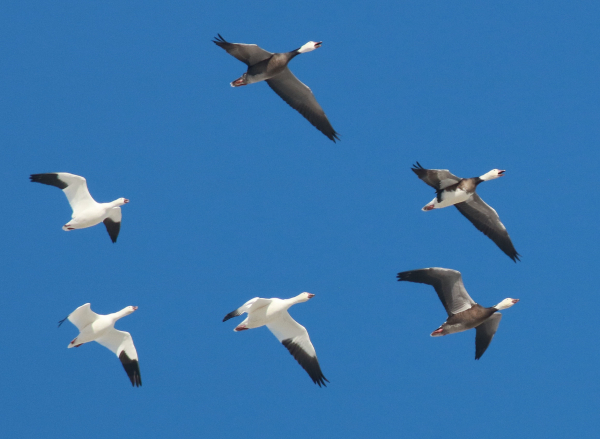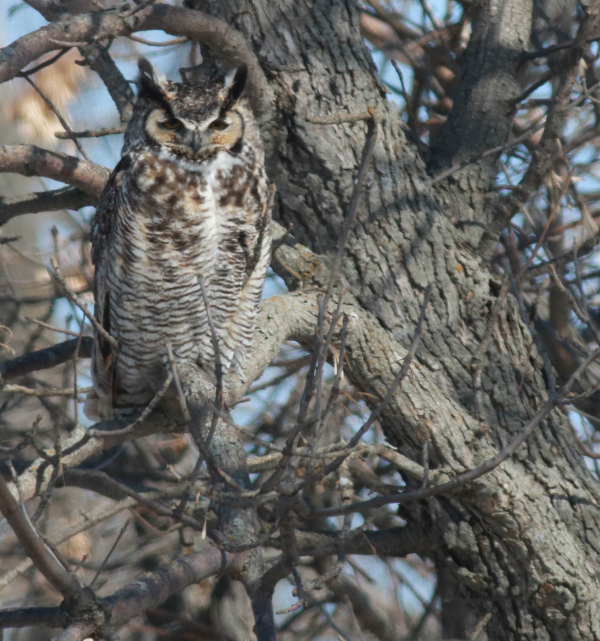
A small portion of the first flock Snow Geese with the usual minority of Ross’s Geese. The two geese in the bottom left side of the photo are Ross’s Geese, which can best be identified by their smaller head and beak, feet, and overall size. Blue morph Snows are impressive geese, and this photo shows one with a white belly, an indication of mixed-breeding between a blue and white morph pair.

The color of this large female Great Horned Owl allows her to blend into her surroundings of bare tree branches. Some Great Horned Owls in the area are incubating new eggs and this female will probably join those ranks soon.
|
Wow, spring broke decisively Saturday! Starting with a surprise flock of seven Giant Canada Geese a half-mile away from home as I began an afternoon drive to Bismarck. Before I fully digested that sighting, two miles to the west I was excited to see a big flock of Snow Geese flying south against the light wind. I stopped to listen to the goose music and take a couple photos as they flew overhead – Yahoo! Then I realized there were three pairs of Giant Canadas acting territorially on the thawing edge of a frozen marsh – what a difference a sunny day with a light south wind makes!
Within the next 30 miles I would see two more flocks of about 200 Snow Geese mixed with some Ross’s Geese, along with scattered pairs and trios of Giant Canada Geese. After enjoying the advance thrust of geese, the big surprise was probably my early sighting of a big female Ferruginous Hawk about 30 miles northwest of home – the first hawk of the year I’ve seen north of the Dakota border. In the area near the Ferrug, I also found two incubating Great Horned Owls within three miles, and I observed another incubating about 30 miles east of Bismarck. And as I approached Bismarck, a pair of Bald Eagles was occupying a nest just 10 miles east of the capitol city, with one eagle standing on the side of the nest and the other perched on an adjacent branch.
To tie these exciting spring sightings with the best of winter, I searched the Steele area for the Snowy Owls I’ve been monitoring in that area – but although I surveyed the area about an hour before sunset, I could find no sign of Snowy Owls. As I approached Bismarck, with a lack of goose observations for almost 90 miles, a stream of flocks of Canada Geese was winging north. The flocks showed a mix of sizes of Canadas, indicating there were a number of subspecies represented, along with a sprinkling of smaller Cackling Geese. It was quite a sight with the sun about to set west of the Missouri River.
Scouting Drive
Monday’s sunshine pressed me outside early to check for geese, Great Horned Owls, and Bald Eagles especially. I checked the location where I had seen three pairs of Giant Canada Geese a couple miles northwest of my office, and found six Canadas feeding, but they were obviously not as territorial as they acted Saturday afternoon. I traveled about 60 miles round trip and didn’t see another goose until I was three miles east of home, where a flock of at least 40 Giants was feeding on corn at the edge of a small runoff wetland.
I was glad to find my favorite female Great Horned Owl 11 miles south of my office, sunning on the edge of a of a grove of trees. I photographed her and was happy she is becoming ever-more trusting, permitting me to reposition to avoid twigs between us, which required restarting my vehicle, moving a few feet, shutting off the engine, and photographing again. I left her appreciating the warmth of the sun that chilly morn. I’m a bit surprised she isn’t incubating on a borrowed nest yet, but she is undoubtedly noon destined for the long incubation and brooding period when she will be very nest bound.
Farther down the road I checked the Bald Eagle nest I monitored last year, but I couldn’t see any eagles perched in the area. When I approached closer I glassed the nest with binoculars and didn’t see any evidence of a bird initially, but it looked like there were fresh branches added to the top of the big nest. A look from another angle revealed the dark feathers of an eagle wing, or was that a leftover goose wing from last year. I reversed course to looked again from a southern vantage point and the big female raised her head to look my way. From this angle I could see most of the top of her incubating body and bid her well at the start of this nesting season that March 9th morn.
Merlin Hunt
The Monday before, I found a Merlin in hunting mode a few miles northeast of my office. It hunted from a couple perches, and when I was closest to the little falcon, it took wing, climbing very high, then abruptly pulled into an extreme dive after supposed prey I couldn’t see – probably a Horned Lark. The supposed lark apparently tried to elude the Merlin by winging into the low vegetation of a small snow-covered marsh, but the Merlin was relentless in its pursuit, twisting in flight among the low plants, then repositioning about 10 feet overhead and diving into the action again and again until I lost her. My impression was that she caught her prey and stayed on the ground to feed. Although much of this hunting episode was left to my speculation, it was interesting to follow with binoculars nonetheless.
Feeder Influx
In addition to the usual feeder visitors – Downy and Hairy Woodpeckers, Blue Jays, and White-breasted Nuthatches – I have enjoyed the more recent mini-additions, namely the little Red-breasted Nuthatch, along with up to three Pine Siskins at a time – until Wednesday, when six siskins appeared simultaneously. Tuesday I was surprised by the addition of another new species – a female House Finch. I didn’t see the female Wednesday, but a colorful male arrived Thursday to add to the feeder action, and by Sunday there were as many as three colorful males at a time. There was at least one more Red-breasted Nuthatch in the mix Sunday, along with two new spring species at my feeding station – a few Dark-eyed Juncos and three American Tree Sparrows, a rare species in these parts.
Monday, as I returned from my morning scouting drive, I was greeted with another surprise: A House Finch singing with gusto outside my door – the first birdsong to break the long Dakota winter. Signs of spring have definitely spiced things up a bit since Saturday, so there should be some fun observations in coming weeks as the first migrants push north with more conviction. Enjoy all your birding opportunities, at home and afield.
Article and photos by Paul Konrad
Share your bird sightings and photos at editorstbw2@gmail.com